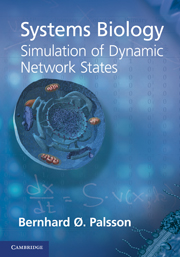Book contents
- Frontmatter
- Contents
- Preface
- 1 Introduction
- 2 Basic concepts
- PART I SIMULATION OF DYNAMIC STATES
- 3 Dynamic simulation: the basic procedure
- 4 Chemical reactions
- 5 Enzyme kinetics
- 6 Open systems
- PART II BIOLOGICAL CHARACTERISTICS
- PART III METABOLISM
- PART IV MACROMOLECULES
- APPENDIX A Nomenclature
- APPENDIX B Homework problems
- References
- Index
6 - Open systems
from PART I - SIMULATION OF DYNAMIC STATES
Published online by Cambridge University Press: 05 August 2012
- Frontmatter
- Contents
- Preface
- 1 Introduction
- 2 Basic concepts
- PART I SIMULATION OF DYNAMIC STATES
- 3 Dynamic simulation: the basic procedure
- 4 Chemical reactions
- 5 Enzyme kinetics
- 6 Open systems
- PART II BIOLOGICAL CHARACTERISTICS
- PART III METABOLISM
- PART IV MACROMOLECULES
- APPENDIX A Nomenclature
- APPENDIX B Homework problems
- References
- Index
Summary
All of the examples in the previous two chapters were closed systems. The ultimate state of closed, chemically reacting systems is chemical equilibrium. Living systems are characterized by mass and energy flows across their boundaries that keep them away from equilibrium. We now discuss open systems, which allow molecules to enter and leave. Open systems ultimately reach a steady state that is often close to a homeostatic state of interest.
Basic concepts
There are several fundamental concepts that need to be understood when one considers open systems. We discuss the more significant ones in this section.
The system boundary Implicit in the term “open system” is the notion of an inside and an outside, the division of the world into two domains. The separation between the two is the system boundary, which thus defines what is inside a system, and belongs to it, and what is outside.
The definition of a boundary can be physical. An example of a physical boundary may be the cell wall, which clearly defines what is inside and what is outside. Similarly, the outer membrane of the mitochondria can serve as a clearly defined physical system boundary. Thus, systems can have hard, immovable boundaries or soft, flexible ones. In the latter case, the volume of the system may be changing.
The definition of a boundary can also be virtual. For instance, we can define a pathway, such as the tricarboxylic acid cycle, as a system, or the amino acid biosynthetic pathways in a cell as a system.
- Type
- Chapter
- Information
- Systems Biology: Simulation of Dynamic Network States , pp. 97 - 108Publisher: Cambridge University PressPrint publication year: 2011



